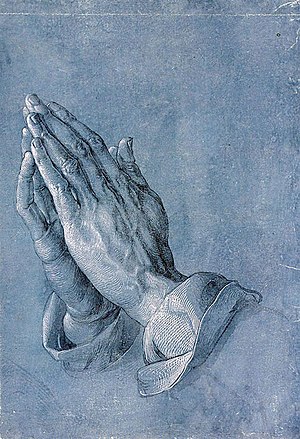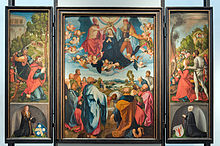Praying hands

|
| Praying hands |
|---|
| Albrecht Dürer , around 1508 |
| Brushes in gray and black, washed with gray, heightened with opaque white, on blue-primed paper |
| 29.1 x 19.7 cm |
| Albertina, Vienna |

Praying Hands (also: Study for the Hands of an Apostle ) is a drawing by Albrecht Dürer . The picture drawn with ink and white heightening on a blue background shows two hands joined in prayer. It is probably the artist's most frequently reproduced picture. The original is in the Albertina in Vienna.
Emergence
The Frankfurt cloth merchant Jakob Heller commissioned Dürer to make a winged altar , the so-called Heller altar . Only preliminary studies of the original have survived after the altar burned in 1729. This includes Praying Hands , a study sheet depicting the hands of an apostle who witnessed the Ascension of Mary . Dürer made the drawing in 1508 in preparation for the central panel of the altar as a hand study, optically doubling his own left hand on a mirror and using a second to obtain the perspective recorded in the picture as a drawing template. The same sheet of paper originally contained the draft of an apostle's head; the sheet was later divided. The apostle is on the right edge of the middle section of the Heller altar.
reception
The Praying Hands were only a preliminary study for the Heller Altar, but they became better known than the work for which they were intended:
“The care Dürer put into these details paid off, at least posthumously. While the bare feet of the apostle kneeling in the foreground triggered a true foot fetishism at the end of the 16th century, the “praying hands” became Dürer's most popular motif in the 20th century. The artist kept the study sheets and picked up some motifs in a slightly modified form several times. "
The Praying Hands are the most widely reproduced work by Dürer. They are mainly offered in the devotional goods trade, often in three-dimensional form, and trivialized as a “synonym of prayer” through translation into other visual media, for example as relief tablets. The praying hands became confirmation gifts, illustrated Bible editions and condolence cards. In treatises on the subject of kitsch , this motif is sometimes cited as the epitome of kitsch. In Europe the motif is mainly sold as a print and as a relief tablet; In the United States, sculptures also find numerous buyers.
The praying hands come from a sheet to which the head of the apostle kneeling on the right belonged. But because the hands were separated from the head, they could become a popular symbol of religiosity.
"The lack of who they belong to, the naive, believing disciple, released his hands for a reinterpretation in which they were worshiped as if they were the Father of God."
The reproductions of the picture and their distribution also provoked opposition. In 1970, for example, the Heidelberg graphic artist Klaus Staeck created a screen print entitled “To Confirmation”, in which he depicted the praying hands with two wing nuts screwed together over a threaded rod. In 2019 the artist Sebastian Wanke installed a neon sculpture entitled PRAY in the Herz-Jesu-Kirche in Erlangen, referring to the mundane kitsch of the motif.
Praying hands with Dürer
literature
- Hermann Bauer: Dürer's “Praying Hands”. In: The Minster. 25.1972, pp. 43-52
- Johann Konrad Eberlein : Albrecht Dürer. Reinbek: Rowohlt Taschenbuch Verlag, 2003. ISBN 3-499-50598-3
- Anja-Franziska Eichler: Albrecht Dürer 1471–1528. Cologne: Könemann Verlagsgesellschaft, 1999. ISBN 3-8290-1634-4 (p. 135)
- Karin Wimmer: Albrecht Dürer's “Praying Hands” and their trivialized reception. Investigation into the representation of Dürer's own hand and the popularity of the motif in the 20th century. Innsbruck: 1999 (dissertation University of Innsbruck )
- Eva Schickler: Strokes of genius by the world artist Albrecht Dürer - The Genius of a Cosmopolitan Artist. German / English with a foreword by Joschka Fischer, Nuremberg: Tümmel, 2005. ISBN 3-921590-32-9
- Norbert Wolf : Albrecht Dürer 1471–1528. The genius of the German Renaissance. Cologne: Taschen, 2006. ISBN 3-8228-4919-7
Web links
- www.theophil-online.de
- Dürer's city of Nuremberg
- Uta Baier: How Albrecht Dürer invented the “praying hands” . Die Welt , December 24, 2008.
Individual evidence
- ^ Grebe: Albrecht Dürer - artist, work and time
- ↑ Call God: Prayer Postures in Advertisements ( Memento of March 7, 2012 in the Internet Archive )
- ↑ Eberlein: Albrecht Dürer
- ↑ Œuvres graphiques de onze artistes de renaé nationale et international de la Heidelberger Künstlergruppe 79 ( Memento from September 28, 2007 in the Internet Archive )

